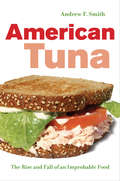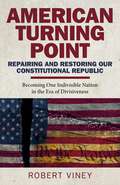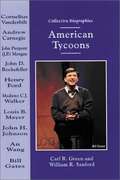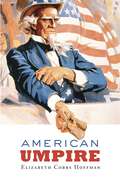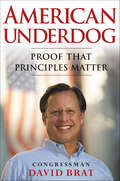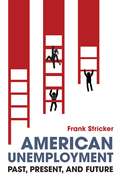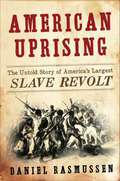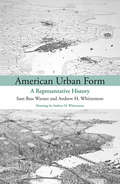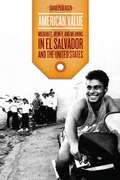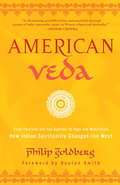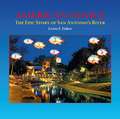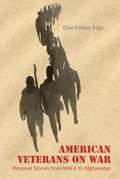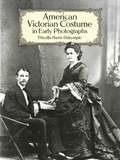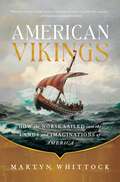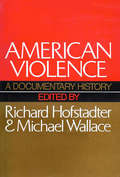- Table View
- List View
American Tuna
by Andrew F. SmithIn a lively account of the American tuna industry over the past century, celebrated food writer and scholar Andrew F. Smith relates how tuna went from being sold primarily as a fertilizer to becoming the most commonly consumed fish in the country. In American Tuna, the so-called "chicken of the sea" is both the subject and the backdrop for other facets of American history: U.S. foreign policy, immigration and environmental politics, and dietary trends. Smith recounts how tuna became a popular low-cost high-protein food beginning in 1903, when the first can rolled off the assembly line. By 1918, skyrocketing sales made it one of America's most popular seafoods. In the decades that followed, the American tuna industry employed thousands, yet at at mid-century production started to fade. Concerns about toxic levels of methylmercury, by-catch issues, and over-harvesting all contributed to the demise of the industry today, when only three major canned tuna brands exist in the United States, all foreign owned. A remarkable cast of characters-- fishermen, advertisers, immigrants, epicures, and environmentalists, among many others--populate this fascinating chronicle of American tastes and the forces that influence them.
American Turnaround: Reinventing AT&T and GM and the Way We Do Business in the USA
by Leslie Cauley Edward WhitacreEd Whitacre is credited with taking over the corporate reins at General Motors (GM) when the automotive manufacturer was on the brink of bankruptcy during 2009 and turned the company around in magnificent fashion. In this business memoir, the native Texan explores his unique management style, business acumen and patriotism.It was President Obama who reached out to Ed Whitacre to come out of retirement and take over GM in 2009. A down-to-earth, no-nonsense Texas native with a distinctive Texas twang in his voice, Whitacre was reluctant to come out of retirement to work at GM. But Whitacre is that rare CEO with great charisma and extraordinary management instincts. And when he got to Detroit, he started to whittle down the corporate bureaucracy right away - and got GM back on track in record timeBefore being pulled out of retirement to run GM by Obama, Ed Whitacre had spent his entire corporate career in the telecom business, where he ultimately ended up running AT&T.
American Turning Point - Repairing and Restoring Our Constitutional Republic: Becoming One Indivisible Nation in the Era of Divisiveness
by Robert Viney'This is a book full of brilliant ideas for change that could form the basis of addressing some of the big challenges for the United States in this turbulent century: the political, socio-economic, and judicial divisions in the nation in particular. It offers detailed ideas which are practical and thought-provoking. Highly recommended for every citizen who cares about the trajectory of America!' Admiral James Stavridis, USN (Ret) is the 14th Chair of the Board of Trustees of the Rockefeller Foundation; he retired as a 4-Star AdmiralAmerican Democracy is at a Turning Point. Most of the American people believe our government is on the wrong track, is broken, and is not capable of solving our major problems. Our national leaders have for too long made the rules for how we are governed for the benefit of their careers and re-election, primarily serving partisan and donor interests instead of serving the country. This book will present fact-based, unbiased and non-partisan actions that "We the People" can take to restore a service-to-country culture in Congress and the Administration.
American Tycoons (Collective Biographies)
by Carl R. Green William R. SanfordEach book presents ten short biographies of important people for the price of a single volume. - This series includes books that are organized around interesting themes, highlight possible career choices, and include women and minorities.
American Ulysses: A Life of Ulysses S. Grant
by Ronald C. WhiteNEW YORK TIMES BESTSELLER • From the author of A. Lincoln, a major new biography of one of America’s greatest generals—and most misunderstood presidentsFinalist for the Gilder-Lehrman Military History Book Prize In his time, Ulysses S. Grant was routinely grouped with George Washington and Abraham Lincoln in the “Trinity of Great American Leaders.” But the battlefield commander–turned–commander-in-chief fell out of favor in the twentieth century. In American Ulysses, Ronald C. White argues that we need to once more revise our estimates of him in the twenty-first. Based on seven years of research with primary documents—some of them never examined by previous Grant scholars—this is destined to become the Grant biography of our time. White, a biographer exceptionally skilled at writing momentous history from the inside out, shows Grant to be a generous, curious, introspective man and leader—a willing delegator with a natural gift for managing the rampaging egos of his fellow officers. His wife, Julia Dent Grant, long marginalized in the historic record, emerges in her own right as a spirited and influential partner. Grant was not only a brilliant general but also a passionate defender of equal rights in post-Civil War America. After winning election to the White House in 1868, he used the power of the federal government to battle the Ku Klux Klan. He was the first president to state that the government’s policy toward American Indians was immoral, and the first ex-president to embark on a world tour, and he cemented his reputation for courage by racing against death to complete his Personal Memoirs. Published by Mark Twain, it is widely considered to be the greatest autobiography by an American leader, but its place in Grant’s life story has never been fully explored—until now. One of those rare books that successfully recast our impression of an iconic historical figure, American Ulysses gives us a finely honed, three-dimensional portrait of Grant the man—husband, father, leader, writer—that should set the standard by which all future biographies of him will be measured.
American Umpire
by Elizabeth Cobbs HoffmanCommentators frequently call the United States an empire: occasionally a benign empire, sometimes an empire in denial, and often a destructive empire. Elizabeth Cobbs Hoffman asserts instead that, because of its unusual federal structure, America has performed the role of umpire since 1776, compelling adherence to rules that gradually earned collective approval. This provocative reinterpretation traces America’s role in the world from the days of George Washington, Abraham Lincoln, and Franklin D. Roosevelt to the present. Cobbs Hoffman argues that the United States has been the pivot of a transformation that began outside its borders and before its founding, in which nation-states replaced the empires that had dominated history. The “Western” values that America is often accused of imposing were, in fact, the result of this global shift. American Umpire explores the rise of three values-access to opportunity, arbitration of disputes, and transparency in government and business-and finds that the United States is distinctive not in its embrace of these practices but in its willingness to persuade and even coerce others to comply. But America’s leadership is problematic as well as potent. The nation has both upheld and violated the rules. Taking sides in explosive disputes imposes significant financial and psychic costs. By definition, umpires cannot win. American Umpire offers a powerful new framework for reassessing the country’s role over the past 250 years. Amid urgent questions about future choices, this book asks who, if not the United States, might enforce these new rules of world order?
American Underdog: Proof That Principles Matter
by David BratFrom David Brat, the college professor who made political headlines when he unseated Majority Leader Eric Cantor, comes his plan for restoring fiscal liberty for America.Congressman David Brat's odds-defying win against Eric Cantor -- a triumph of a modest $200,000 campaign fund against a $5 million war chest -- immediately brought David Brat, heretofore a liberal arts college economics professor, into the political limelight. Now, in his first book, American Underdog, Brat examines how we brought down the status quo by tapping into moral and economic lessons as old as our civilization and discusses how Washington can learn from history instead of ignoring it. A fighter for children, he illuminates how our current fiscal policies are selling their future, and outlines new ways to move forward with a conservative agenda that provides fairer treatment for all.
American Unemployment: Past, Present, and Future
by Frank StrickerThe history of unemployment and many concepts surrounding it remain a mystery to many Americans. Frank Stricker believes we need to understand this essential thread in our shared past. American Unemployment is an introduction for everyone that takes aim at misinformation, willful deceptions, and popular myths to set the record straight: <P><P> Workers do not normally choose to be unemployed. In our current system, persistent unemployment is not an aberration. It is much more common than full employment, and the outcome of elite policy choices. Labor surpluses propped up by flawed unemployment numbers have helped to keep real wages stagnant for more than forty years. Prior to the New Deal and the era of big government, laissez-faire policies repeatedly led to depressions with heavy, even catastrophic, job losses. Undercounting the unemployed sabotages the creation of government job programs that can lead to more high-paying jobs and full employment. <P><P> Written for non-economists, American Unemployment is a history and primer on vital economic topics that also provides a roadmap to better jobs and economic security.
American Uprising: The Untold Story of America's Largest Slave Revolt
by Daniel Rasmussen&“A chilling and suspenseful account [of] the culmination of a signal episode in the history of American race relations.&” —Adam Goodheart, The New York Times Book Review In January 1811, five hundred slaves, dressed in military uniforms and armed with guns, cane knives, and axes, rose up from the plantations around New Orleans and set out to conquer the city. Ethnically diverse, politically astute, and highly organized, this self-made army challenged not only the economic system of plantation agriculture but also American expansion. Their march represented the largest act of armed resistance against slavery in the history of the United States. American Uprising is the riveting, long-neglected story of the rebel army's dramatic march on the city, and its shocking conclusion. No North American slave uprising—not Gabriel Prosser's, not Denmark Vesey's, not Nat Turner's—has rivaled the scale of this rebellion either in terms of the number of the slaves involved or the number who were killed. More than one hundred slaves were slaughtered by federal troops and French planters, who then sought to write the event out of history and prevent the spread of the slaves' revolutionary philosophy. Through groundbreaking research, Daniel Rasmussen offers a window into expansionist America, illuminating the early history of New Orleans and providing new insight into the path to the Civil War and the slave revolutionaries who fought and died for the hope of freedom. &“Crisp, confident . . . Rasmussen tells this story with verve.&” —John Stauffer, The Wall Street Journal &“Breathtaking. . . . [A] fascinating narrative of slavery and resistance [that] tells us something about history itself—about how fiction can become fact, and how &‘history&’ is sometimes nothing more than erasure.&” —Henry Louis Gates, Jr.
American Urban Form
by Sam Bass Warner Andrew H. WhittemoreAmerican urban form--the spaces, places, and boundaries that define city life--has been evolving since the first settlements of colonial days. The changing patterns of houses, buildings, streets, parks, pipes and wires, wharves, railroads, highways, and airports reflect changing patterns of the social, political, and economic processes that shape the city. In this book, Sam Bass Warner and Andrew Whittemore map more than three hundred years of the American city through the evolution of urban form. They do this by offering an illustrated history of "the City"--a hypothetical city that exemplifies the American city's transformation from village to merchant seaport, industrial city, multicentered metropolis, and, finally, regional metropolis that participates in both the local and the global. The book thereby offers a yardstick against which readers can measure the history of their city. Warner and Whittemore have constructed their hypothetical City from the histories of Boston, Philadelphia, and New York, focusing on commonalities that make up key patterns in American urban development. In an engaging text accompanied by Whittemore's detailed, meticulous drawings, they chart the City's changing boundaries, densities, building styles, transportation infrastructures, and population patterns. Planning for the future of cities, they remind us, requires an understanding of the forces that shaped the city's past; these are the tools of urban change. The city's protean, ever-changing nature offers each generation a fresh chance to reform (and re-form) it.
American Urban Form: A Representative History (Urban and Industrial Environments)
by Sam Bass Warner Andrew WhittemoreAn illustrated history of the American city's evolution from sparsely populated village to regional metropolis.American Urban Form—the spaces, places, and boundaries that define city life—has been evolving since the first settlements of colonial days. The changing patterns of houses, buildings, streets, parks, pipes and wires, wharves, railroads, highways, and airports reflect changing patterns of the social, political, and economic processes that shape the city. In this book, Sam Bass Warner and Andrew Whittemore map more than three hundred years of the American city through the evolution of urban form. They do this by offering an illustrated history of “the City”—a hypothetical city (constructed from the histories of Boston, Philadelphia, and New York) that exemplifies the American city's transformation from village to regional metropolis.In an engaging text accompanied by Whittemore's detailed, meticulous drawings, they chart the City's changes. Planning for the future of cities, they remind us, requires an understanding of the forces that shaped the city's past.
American Urban Politics in a Global Age
by James M. Smith Annika Marlen HinzeBringing together a selection of readings that represent some of the most important trends and topics in urban scholarship today, American Urban Politics in a Global Age provides historical context and contemporary commentaries on the economy, politics, culture, and identity of American cities. The eighth edition of this well-rounded and popular urban politics reader maintains the wide variety of reading selections it is known for, as well as many “classics,” while adapting to current events and developments in urban politics, and engaging cities in a post-pandemic world. All-new readings and important editorial commentary include: • Recent political debates about policing, race, and ethnicity in the urban environment; • The impact of climate change on cities, and their roles in mitigating it, as well as preparing for it; • A discussion of gender politics in post-Trump American cities; • A reflection on the increasing importance of private players in city- and metro-politics, from implications for governance, to the growing corporate aspect of smart city initiatives, designed to help urban governments provide important services across cities and metropolitan regions; and • An examination of the COVID-19 pandemic, and its impact on cities, from the initial, devastating outbreak in New York City in March 2020, to recurring shutdowns, life, urban development, and social polarization post-COVID. American Urban Politics in a Global Age remains an approachable scholarly resource for undergraduate and graduate classrooms, as well as a general, wide-ranging scholarly overview of the most important aspects of the field for researchers. It may be taught alongside City Politics: Cities and Suburbs in 21st Century America.
American Urban Politics in a Global Age
by Paul Kantor Dennis R JuddBringing together a selection of readings that represent some of the most important trends and topics in urban scholarship today, American Urban Politics provides historical context and contemporary commentaries on the economy, politics, culture and identity of American cities. This seventh edition examines the ability of highly autonomous local governments to grapple with the serious challenges of recent years, challenges such as the stresses of the lingering economic crisis, and a series of recent natural disasters. Features: Each chapter is introduced by an editor's essay that places the readings into context and highlights their central ideas and findings. Division into three historical periods emphasizes both the changes and continuities in American urban politics over time. The reader is the perfect complement for Judd & Swanstrom's City Politics: The Political Economy of Urban American, 7/e, also available in a new edition (ISBN 0-205-03246-X)
American Utopia and Social Engineering in Literature, Social Thought, and Political History (Routledge Transnational Perspectives on American Literature)
by Peter SwirskiThe United States today is afflicted with political alienation, militarized violence, institutionalized poverty, and social agony. Worst of all, perhaps, it is afflicted with chronic and acute ahistoricism. America insist on ignoring the context of its present dilemmas. It insists on forgetting what preceded the headlines of today and on denying continuity with history. It insists, in short, on its exceptionalism. American Utopia and Social Engineering sets out to correct this amnesia. It misses no opportunity to flesh out both the historical premises and the political promises behind the social policies and political events of the period. These interdisciplinary concerns provide, in turn, the framework for the analyses of works of American literature that mirror their times and mores. Novels considered include: B.F. Skinner and Walden Two (1948), easily the most scandalous utopia of the century, if not of all times; Ken Kesey’s One Flew Over the Cuckoo’s Nest (1962), an anatomy of political disfranchisement American-style; Bernard Malamud’s God’s Grace (1982), a neo-Darwinian beast fable about morality in the thermonuclear age; Walker Percy’s The Thanatos Syndrome (1986), a diagnostic novel about engineering violence out of America’s streets and minds; and Philip Roth’s The Plot Against America (2004), an alternative history of homegrown ‘soft’ fascism. With the help of the five novels and the social models outlined therein, Peter Swirski interrogates key aspects of sociobiology and behavioural psychology, voting and referenda procedures, morality and altruism, multilevel selection and proverbial wisdom, violence and chip-implant technology, and the adaptive role of emotions in our private and public lives.
American Utopia: Literature, Society, and the Human Use of Human Beings
by Peter SwirskiFrom Black Tuesday to the White House, from Plato to Robert Nozick, from Eugene Debs to Richard Nixon, from Peter Cornelis Plockhoy to the hippie communes of the Sixties, from universal basic income to utopian basic income, from proverbial wisdom to multilevel selection, from Big Data to paleomorality, from Prisoner’s Dilemma to social-engineering Israeli kindergartens, from time travel to gene engineering, from the pretzel logic of meritocracy to deaggressing humanity, American Utopia maps the pitfalls and windfalls of social reform in the name of the human use of human beings. Interrogating the assumptions behind four outré utopias by Thomas M. Disch, Bernard Malamud, Kurt Vonnegut, and Margaret Atwood, the book interrogates the assumptions that have historically been central to the utopian project. Whence the seeds of social discontent? Whence our taste for egoism and altruism? For waging war and waging peace? Can we bioengineer human nature to specifications? Should we? Who makes better guardians: humans or machines? And who will guard the guardians?
American Value: Migrants, Money, and Meaning in El Salvador and the United States
by David PedersenOver the past half-century, El Salvador has transformed dramatically. Historically reliant on primary exports like coffee and cotton, the country emerged from a brutal civil war in 1992 to find much of its national income now coming from a massive emigrant workforceOCoover a quarter of its populationOCothat earns money in the United States and sends it home. In American "Value," David Pedersen examines this new way of life as it extends across two places: Intipuci, a Salvadoran town infamous for its remittance wealth, and the Washington, DC, metro area, home to the second largest population of Salvadorans in the United States. aPedersen charts El SalvadorOCOs change alongside American deindustrialization, viewing the Salvadoran migrant work abilities used in new lowwage American service jobs as a kind of primary export, and shows how the latest social conditions linking both countries are part of a longer history of disparity across the Americas. Drawing on the work of Charles S. Peirce, he demonstrates how the defining value formsOComigrant work capacity, services, and remittancesOCoact as signs, building a moral world by communicating their exchangeability while hiding the violence and exploitation on which this story rests. Theoretically sophisticated, ethnographically rich, and compellingly written, "American Value" offers critical insights into practices that are increasingly common throughout the world.
American Values: Lessons I Learned from My Family (Identification And Value Guide Ser.)
by Robert F. Kennedy Jr.With rich detail, compelling honesty, and a storyteller’s gift, RFK Jr. describes his life growing up Kennedy in a tumultuous time in history that eerily echoes the issues of nuclear confrontation, religion, race, and inequality that we confront today.In this powerful book that combines the best aspects of memoir and political history, the third child of Attorney General Robert Kennedy and nephew of JFK takes us on an intimate journey through his life, including watershed moments in the history of our nation. Stories of his grandparents Joseph and Rose set the stage for their nine remarkable children, among them three U.S. senators—Teddy, Bobby, and Jack—one of whom went on to become attorney general, and the other, the president of the United States. We meet Allen Dulles and J. Edgar Hoover, two men whose agencies posed the principal threats to American democracy and values. Their power struggles with the Kennedys underpinned all the defining conflicts of the era. We live through the Cuban Missile Crisis, when insubordinate spies and belligerent generals in the Pentagon and Moscow brought the world to the cliff edge of nuclear war. At Hickory Hill in Virginia, where RFK Jr. grew up, we encounter the celebrities who gathered at the second most famous address in Washington, members of what would later become known as America’s Camelot. Through his father’s role as attorney general we get an insider’s look as growing tensions over civil rights led to pitched battles in the streets and 16,000 federal troops were called in to enforce desegregation at Ole Miss. We see growing pressure to fight wars in Southeast Asia to stop communism. We relive the assassination of JFK, RFK’s run for the presidency that was cut short by his own death, and the aftermath of those murders on the Kennedy family.These pages come vividly to life with intimate stories of RFK Jr.’s own experiences, not just with historical events and the movers who shaped them but also with his mother and father, with his own struggles with addiction, and with the ways he eventually made peace with both his Kennedy legacy and his own demons. The result is a lyrically written book that is remarkably stirring and relevant, providing insight, hope, and steady wisdom for Americans as they wrestle, as never before, with questions about America’s role in history and the world and what it means to be American.
American Vandal
by Roy MorrisUnintimidated by Old World sophistication or travel to undeveloped parts of the globe, Mark Twain spent a surprising amount of time outside the continental United States. Roy Morris, Jr. focuses on the dozen years he lived overseas and the books he wrote encouraging middle-class Americans to follow him around the world, at the dawn of mass tourism.
American Veda: From Emerson and the Beatles to Yoga and Meditation How Indian Spirituality Changed the West
by Philip GoldbergIn February 1968 the Beatles went to India for an extended stay with their new guru, Maharishi Mahesh Yogi. It may have been the most momentous spiritual retreat since Jesus spent those forty days in the wilderness. With these words, Philip Goldberg begins his monumental work, American Veda, a fascinating look at India’s remarkable impact on Western culture. This eye-opening popular history shows how the ancient philosophy of Vedanta and the mind-body methods of Yoga have profoundly affected the worldview of millions of Americans and radically altered the religious landscape. What exploded in the 1960s actually began more than two hundred years earlier, when the United States started importing knowledge as well as tangy spices and colorful fabrics from Asia. The first translations of Hindu texts found their way into the libraries of John Adams and Ralph Waldo Emerson. From there the ideas spread to Henry David Thoreau, Walt Whitman, and succeeding generations of receptive Americans, who absorbed India’s “science of consciousness” and wove it into the fabric of their lives. Charismatic teachers like Swami Vivekananda and Paramahansa Yogananda came west in waves, prompting leading intellectuals, artists, and scientists such as Aldous Huxley, Joseph Campbell, Allen Ginsberg, J. D. Salinger, John Coltrane, Dean Ornish, and Richard Alpert, aka Ram Dass, to adapt and disseminate what they learned from them. The impact has been enormous, enlarging our current understanding of the mind and body and dramatically changing how we view ourselves and our place in the cosmos. Goldberg paints a compelling picture of this remarkable East-to-West transmission, showing how it accelerated through the decades and eventually moved from the counterculture into our laboratories, libraries, and living rooms. Now physicians and therapists routinely recommend meditation, words like karma and mantra are part of our everyday vocabulary, and Yoga studios are as ubiquitous as Starbuckses. The insights of India’s sages permeate so much of what we think, believe, and do that they have redefined the meaning of life for millions of Americans—and continue to do so every day. Rich in detail and expansive in scope, American Veda shows how we have come to accept and live by the central teaching of Vedic wisdom: “Truth is one, the wise call it by many names.”
American Venice
by Lewis F. FisherIn American Venice: The Epic Story of San Antonio's River, Lewis F. Fisher uncovers the evolution of San Antonio's beloved River Walk. He shares how San Antonians refused to give up on the vital water source that provided for them from before the city's beginnings. In 1941 neglect, civic uprisings, and bursts of creativity culminated in the completion of a Works Projects Administration project designed by Robert H. H. Hugman.The resulting River Walk languished for years but enjoyed renewed interest during the 1968 World's Fair, held in San Antonio, and has since become the center of the city's cultural and historical narrative."The real story [of the River Walk] is a bit less Hollywood but far more interesting . . . With a growing number of cities facing issues of water supply, urban runoff, flooding, and ways of rebuilding better after a disaster, the San Antonio River Walk remains a great example of getting it right," writes Irby Hightower, co-chair of the San Antonio River Oversight Committee.In this updated and expanded edition of River Walk: The Epic Story of San Antonio's River, Fisher offers more fascinating stories about the River Walk's evolution, bringing to light new facts and sharing historical images that he has since discovered. The update includes information about the Museum and Mission Reaches, two expansions of the River Walk that are vital to San Antonio's continued growth as the seventh largest city in the country.Fisher starts his story with the first written records of the river, in the 1690s, and continues through the 1800s and the flood of 1921, to debates over transforming the river and its eventual role as the crown jewel of Texas, and finally to its recent expansion. More than a community attraction, the River Walk's banks are also a giant botanical garden full of plants and trees. Indeed, the American Society for Horticulture has named the River Walk a Horticultural Landmark. As Fisher says, the River Walk "remains a work in progress, one forever precarious and unfinished yet standing before the world as a triumph of enterprise and human imagination."
American Veterans on War: Personal Stories from WW II to Afghanistan
by Elise Forbes TrippThe United States is embroiled in conflicts in Iraq and Afghanistan-wars that seem as far from Americans' understanding as they are distant from our shores.With American Veterans on War, Elise Forbes Tripp brings our current wars and their predecessors home in the words of 55 veterans aged 20 to 90. The veterans raise questions about when wars are worth fighting, what missions can and can't be won, and the costs and benefits of US intervention, both around the world and domestically. Recent veterans tell wrenching stories of coping with hostile forces without uniforms, of not knowing who is friend or foe, and of the lasting traces of combat once they've returned home.American Veterans on War provides a sweeping overview of three-quarters of a century of American wars, properly grounding that history in the words of the men and women whose bodies were on the line.
American Victorian Costume in Early Photographs
by Priscilla Harris DalrympleOver 280 rare photographs document the clothing of ordinary men, women, and children from the 1840s through the 1890s, in what appears to be their Sunday best. Bustles, hoops, pantalets, shirtwaists, top hats, waistcoats, bowlers, other Victorian-era attire, as well as hairdressing and tonsorial styles. Introduction to fashions of each decade.
American Victory
by Henry Cejudo"Compelling. . . American Victory represents the triumph of the human spirit. " --Los Angeles Times Henry Cejudo's remarkable journey follows an unlikely hero, the son of illegal immigrants, from the mean streets of South Central LA to the glory of the Beijing Olympics. The first American in sixteen years to win the gold medal in freestyle wrestling and the youngest American gold medalist ever in this event, Henry's grit, passion, and resolve on display in China was a culmination of a life spent fighting-both on and off the mat. American Victory is his poignant and powerful memoir of how he rose above the statistics and dangers to become a winner-and a hero that embodies all that's best and most hopeful in the American dream. .
American Vikings: How the Norse Sailed into the Lands and Imaginations of America
by Martyn WhittockA vivid and illuminating new history—separate fact from fiction, myth from legend—exploring the early Vikings settlements in North America.Vikings are an enduring subject of fascination. The combination of adventure, mythology, violence, and exploration continues to grip our attention. As a result, for more than a millennium the Vikings have traveled far and wide, not least across the turbulent seas of our minds and imaginations. The geographical reach of the Norse was extraordinary. For centuries medieval sagas, first recorded in Iceland, claimed that Vikings reached North America around the year 1000. This book explores that claim, separating fact from fiction and myth from mischief, to assess the enduring legacy of this claim in America. The search for &“American Vikings&” connects a vast range of different areas; from the latest archaeological evidence for their actual settlement in North America to the myth-making of nineteenth-century Scandinavian pioneers in the Midwest; and from ancient adventurers to the political ideologies in the twenty-first century. It is a journey from the high seas of a millennium ago to the swirling waters and dark undercurrents of the online world of today. No doubt, the warlike Vikings would have understood how their image could be &“weaponized.&” In the same way, they would probably have grasped how their dramatic, violent, passionate, and discordant mythologies could appeal to our era and cultural setting. They might, though, have been more surprised at how their image has been commercialized and commodified. A vivid new history by a master of the form, American Vikings explores how the Norse first sailed into the lands, and then into the imaginations, of America.
American Violence
by Richard HofstadterWith eyewitness accounts and contemporary reports--linked together by succinct analytical commentaries--Richard Hofstadter and his young collaborator, Michael Wallace, have created a superb documentary reader that is, in effect, a history of violence in America through four centuries. Here, as experienced by men and women who lived through them, are not only the familiar, chilling eruptions--Harper's Ferry; the Civil War draft riot in New York; Homestead; Centralia; the Detroit ghetto; the assassinations of Lincoln, Malcolm X, and Robert Kennedy--but also less commonly remembered episodes, such as the New York slave riots of 1712, the doctors' riot of 1788, vigilante terror in Montana, the anti-Chinese riot in Los Angeles in 1871, and the White League coup d'état of 1874 in New Orleans. In his extensive introduction, Richard Hofstadter shows how, in the face of the record, Americans have had an extraordinary ability to persuade themselves that they are among the best-behaved and the best-regulated of peoples. With more than one hundred entries, the editors have documented and put into perspective the thread of violence in American history whose rediscovery--as Hofstadter suggests--will undoubtedly be one of the most important intellectual legacies of the 1960's. The book clearly demonstrates, even as the reader comes to grips with long-eluded truths, that America's consistent history of violence has not yet breached beyond hope of restoration our long record of basic political stability, that most social reforms in the United States have been brought about without violence.
